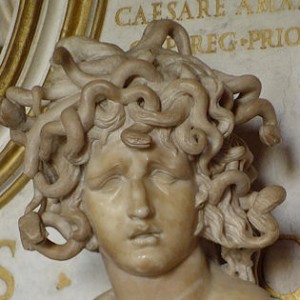Autistic Imagination: Nothing Is Impossible
 Research on creativity has shown that autistic children, when asked to draw a person or thing that could not exist, find it very difficult to do so. Creating more realistic images, however, does not pose such a problem for them. (Scott, F., & Baron-Cohen, S. (1996) Imagining real and unreal things: Evidence of a dissociation in autism. Journal of Cognitive Neuroscience, 8, 400-411.) Non-autistic children are likely to respond by adding features such as extra fingers or two heads when asked to draw a person who could not exist. (Karmiloff-Smith, A. (1989) Constraints on representational change: Evidence from children’s drawings. Cognition, 34, 57-83.) A distinction has developed in the research literature between “imaginative creativity,” which refers to imagining things that could not exist, and “reality-based creativity.” Autistics have been described as having a significant deficit in the former.
Research on creativity has shown that autistic children, when asked to draw a person or thing that could not exist, find it very difficult to do so. Creating more realistic images, however, does not pose such a problem for them. (Scott, F., & Baron-Cohen, S. (1996) Imagining real and unreal things: Evidence of a dissociation in autism. Journal of Cognitive Neuroscience, 8, 400-411.) Non-autistic children are likely to respond by adding features such as extra fingers or two heads when asked to draw a person who could not exist. (Karmiloff-Smith, A. (1989) Constraints on representational change: Evidence from children’s drawings. Cognition, 34, 57-83.) A distinction has developed in the research literature between “imaginative creativity,” which refers to imagining things that could not exist, and “reality-based creativity.” Autistics have been described as having a significant deficit in the former.
As I discussed in my post two weeks ago, because autistics tend to perceive more ambiguity and complexity than the average person, the conclusions drawn from psychological studies may not accurately reflect the characteristics sought to be measured. This difference in perception can be attributed to primary process thinking, which Andrew Lehman, referencing Gregory Bateson, sums up as “one time, one place, no opposites.” In other words, everything is considered from a holistic perspective and on its own terms, rather than being rejected as inconsistent with something else.
To the best of my recollection, I never was given any tests as a child that involved imagining something nonexistent; but here is my fictional account of what I expect might have happened.
“Draw a man who could not exist.”
I sit there for a long time, unable to think of any features that might qualify. Extra fingers certainly won’t do because some babies are naturally born with them. How about a Cyclops or a man with two heads? Well, no, either of those might be a mutation caused by a nuclear disaster or some other toxic catastrophe.
What about something that doesn’t look at all like human features, such as wings or antennae? No, that won’t work either. There are plenty of sci-fi stories about people on other planets with features like that. Even if there’s not much likelihood of such people really existing in another part of the galaxy, that doesn’t mean they could not exist.
The experimenter is still waiting; I’d better go ahead and draw something. Okay, there’s a head, torso, arms and legs, now I’ve got a man. But I still don’t have any idea what might turn him into a man who could not exist. How about drawing a tree next to him, so that he’s as tall as a tree? That’s no good, the tree might be a sapling or a miniature tree; or perhaps the man has some kind of hormonal condition that makes him never stop growing, or he’s from a future colony on a low-gravity planet where everyone is very tall.
I continue to sit there pondering, while the experimenter looks at his watch and makes valiant efforts not to yawn. What if I make the man as tiny as an ant? No, how can I be sure that there won’t be miniaturization devices in the future?
Maybe I should draw snakes on his head like Medusa. But many years from now, a transhumanist group might decide that’s the height of fashion. They might decide to implant themselves with tails and horns, too.
How about a werewolf or some other kind of shape-shifter? Who knows, maybe in a few centuries, bioengineering will have advanced to the point where people can easily transform into some other shape whenever they feel like it.
The crickets are chirping outside the window, the experimenter looks like he’s about to doze off, and the moon is rising in a darkening sky. I don’t have anything on my paper except a plain sketch of a man. Handing it to the experimenter as I leave the room, I wonder if anything truly can be said to be impossible.
Gwen McKay on 07/21/10 in Autism, featured | 2 Comments | Read More
Comments (2)


What an excellent post and a wonderful example of why psychological tests may not be measuring what the psychologists think they are and why despite all the effort, people can be incredibly hard to quantify.
Thanks Kim, glad you enjoyed reading it!